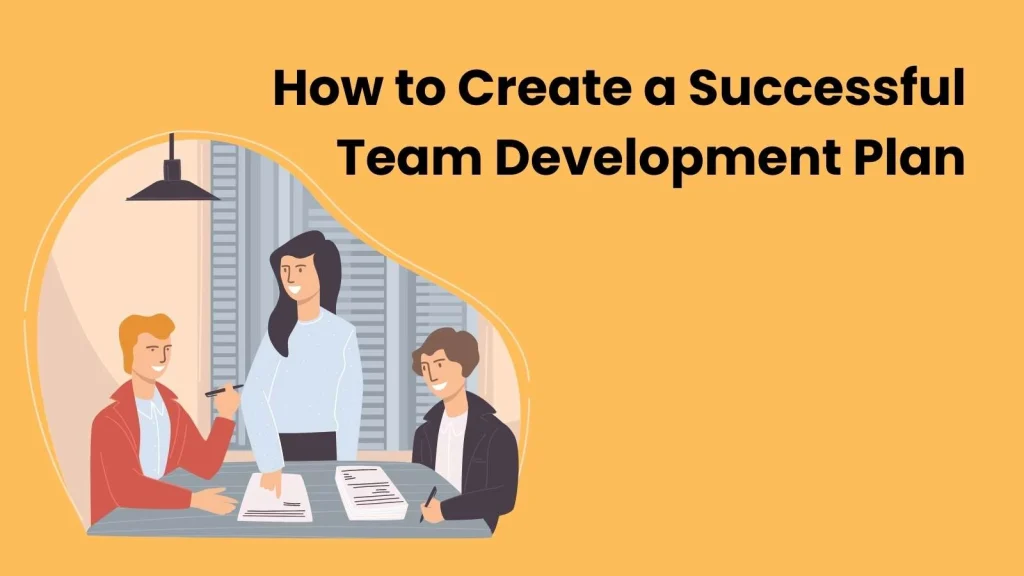Today, many employers are leaning towards team development over individual development. Team development is a good option for organizations with less time and resources to devote to talent development, as well as teams who value collaboration above individual success.
Team development is tailored to collective needs, emphasizes enhancing soft skills like communication and problem-solving, and requires structured team meetings.
Naturally, a plan for team development cannot be as specific and clear-cut as an individual plan, including the employee’s unique goals and assets. Team development should be approached from a wider lens of what the company team needs to work on, develop, and achieve in order to contribute more to the company’s mission.

HOW CAN YOU SET UP A TEAM DEVELOPMENT PLAN?
HR professionals and other experts recommend team talent development the following five elements:
1. TEAM PLANNING DISCUSSIONS
Team talent development should be practical and effective, with collaboration at the forefront of the plan. As such, it is necessary to plan and discuss the development program as a team. Be sure to discuss employee goals, strengths and weaknesses, as well as interests and challenges.
2. COMPANY VALUES
Since your team development plan focuses on your staff as a whole, it should consider company values. Identify your team’s most important values and discuss how the team can embody those values in the workplace.
Suppose your company values transparency. In that case, the company team should incorporate open communication into the plan — both during the development process itself and as an ideal for working towards.
3. COMPANY OBJECTIVES
An integral part of the talent development process is to establish the company’s main objectives. What is the reason for team development? What are the company’s short-term and long-term goals? These objectives should also align with the company values, making the talent development plan a holistic strategy for improving company culture. The objectives should reflect the company’s overall mission, the primary shared goal of which all team members contribute.
4. INDIVIDUAL STRENGTHS AND GOALS
Even in a team development plan, individual employee profiles should be considered: strengths, weaknesses, interests, goals, and all of the essential, relevant information. Examining all team members as individuals who make up a larger body can be vital in creating an effective team development plan. The employer and team can create a plan together that satisfies the common goals amongst the group and utilizes each member’s strengths and weaknesses.
5. TAILORED ACTION PLAN
Team talent development offers many different creative and effective approaches: innovation training, project-based learning, collaborative workshops, challenge-based learning, and more. The employer has the opportunity to tailor the program specifically to the team and the team objectives. They can also combine programs, like, for example, innovation challenge-based learning or innovative work-integrated learning (iWIL) — a highly effective, hands-on, and collaborative experience that inspires colleagues to grow together.
With these strategies in place, employers can build a holistic team development plan, but their support of the process is also key.

HOW CAN THE EMPLOYER SUPPORT A TEAM WITH THEIR COLLABORATIVE DEVELOPMENT?
1. FACILITATE INNOVATIVE AND COLLABORATIVE EXPERIENCES
Team talent development opens up invaluable opportunities not possible with individual development: hands-on collaborative experiences! These programs vary and can involve activities like team-building exercises, interactive workshops, collaborative innovation, and challenge-based learning. Team talent development can combine innovation and project management elements with collaboration to create enriching experiences for diverse employees.
Like with Prepr challenges, employees can team up to develop innovative solutions to real-world problems. This hands-on, collaborative approach builds soft and hard skills applicable in today’s workplace, especially skills like problem-solving, communication, critical thinking, and creativity — some of the most in-demand skills today.
2. ENCOURAGE DIVERSITY
“Diversity” here refers to the inclusion of all employees’ needs being addressed, diversity of ideas flowing from unique employees, and diversity of learning opportunities via stretch assignments, cross-departmental collaboration, and other opportunities that allow employees to diversify their skills and experience. Employers can encourage a culture of diversity with collaborative experiences that join different departments and challenge team members to step out of their comfort zone. Moreover, inclusivity and diversity encourage team members to teach one another throughout their collaborative journey.
3. BREAK DOWN ORGANIZATIONAL SILOS
Silos, information barriers between different departments or members of a team, is an issue that should be squashed by the employer’s leadership and the team’s open communication. Many companies today, beyond just tech companies, adopt the agile or scrum approach to work and project management to create a fluid and as efficient workflow as possible. For team talent development, it is a great idea to adapt workplace communications towards a more open communication work environment.
4. MEASURE THE TEAM’S PROGRESS
The employer should measure progress to ensure that the strategies in place are working. Progress can be measured by looking at collaborative deliverables, meeting with the team to discuss progress, or speaking to team members individually to ascertain the team’s progress. Moreover, because team talent development can be more complex and challenging to track, the employer can use apps for tracking talent development.
5. PROVIDE AND ENCOURAGE CONSTRUCTIVE FEEDBACK
The employer can help the team develop by providing constructive feedback on improving their performance or collaboration. Tracking their progress, the employer can provide helpful feedback. Some companies adopt a team development approach that includes multidirectional feedback. This kind of feedback is between peers, encouraging employees to support one another in their growth, especially when the team is collaborating together, observing each other’s performance regularly.
6. CHECK IN WITH TEAM MEMBERS
Lastly, one-on-one meetings between the employer and individual team members are ideal so that employees can comfortably raise concerns about the team environment. Checking in with individual employees assures them that they are valued within the broader team.
With strong support from leadership, the team develops their skills in a caring environment.

